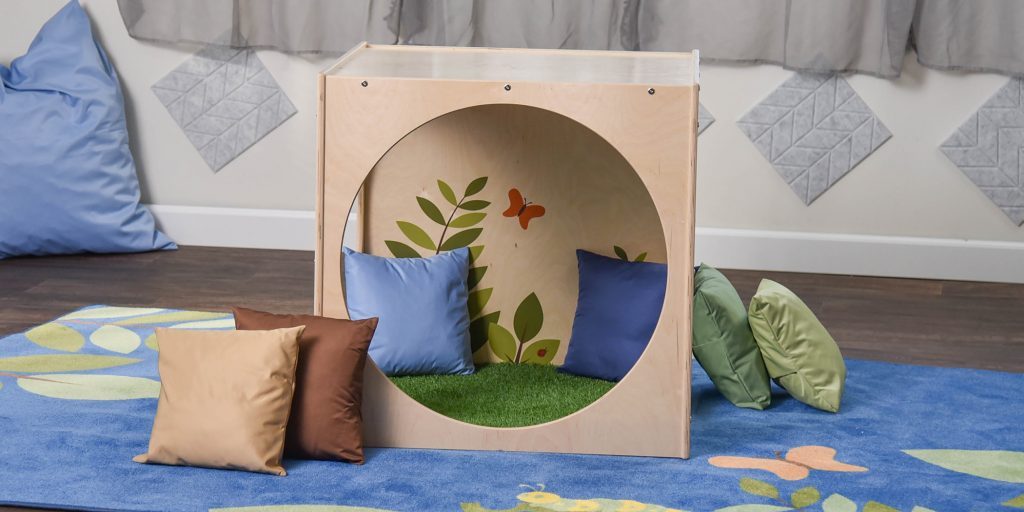
Benefits of Biophilic Design in the Classroom
Technology has significantly affected our culture. Children appear to have become the most profoundly affected age group. Their whole lives revolve around technology, and they have never known a day without it. Can the absence of nature’s elements in the educational environment cause stress levels to be elevated? Can it hinder creativity, cognitive ability, and emotional well-being? Let’s explore the benefits to biophilic design.
The History of Biophilia
In 1984, biologist E.O. Wilson published Biophilia, which explored the evolutionary and psychological basis of humanity’s attraction to the natural environment. His work originated by studying ants, but later was extended to all insects as well as vertebrates. He is also responsible for introducing a new discipline called “sociobiology”. According to the E.O. Wilson Foundation, “the foundational discoveries of sociobiology are generally recognized to be the analysis of animal communication and division of labor, in which Wilson played a principal role, and the genetic theory of the origin of social behavior.” Wilson published Sociobiology: The New Synthesis in 1975, which “was later ranked in a poll of the officers and fellows of the international Animal Behavior Society as the most important book on animal behavior of all time”.
The architectural world has extended Wilson’s research by applying principles from “biophilia” to the built environment. Referred to as “biophilic design”, it is the integration of nature into the built environment. “Biomimicry”, another emerging science, takes lessons from nature and applies them to solve human problems. Biomimicry and biophilic design may provide the answers to the challenges humans face today and in the future. Partner biophilic design and biomimicry with sociobiology and educators might illuminate a further understanding of how social behavior and communication facilitate Social Emotional Learning. (SEL)
14 Patterns of Biophilic Design
According to Browning et al. (2014), there are 14 patterns of biophilic design that can impact human health and wellbeing, such as stress, visual acuity, hormone balance, and creativity within the built environment. Many of the 14 patterns are very complex and will be revisited in more detail in future blogs.
Interestingly, Browning exposes the idea of how virtual connections with nature can have an artificial impact on our feelings of connectivity. The impact is less significant than real visual connections to nature, but sometimes a real connection cannot be achieved. In his example, the subterranean environment of a railway system has effectively used virtual biophilic design to lower traveler’s blood pressure and heart rates to reduce stress and consequently may lead to a heightened sense of well-being.
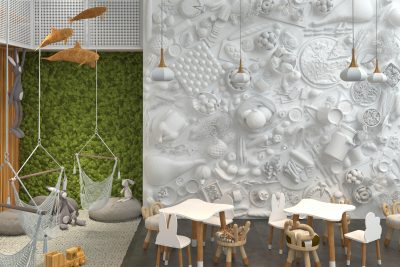
This 3D rendering and green, leafy wall mural add stimulating visuals and provide an artificial nature scene to this kids’ space. It’s the perfect way to bring nature indoors when the real thing is not achievable.
Large windows bringing in an abundance of natural light and providing children with a direct view of nature is optimal. Solar Shades (a type of window covering) can be used to block the sun’s heat and glare while allowing kids to maintain their visual connection with nature. Classrooms might not always be able to provide children with direct visual connections with nature. Therefore, virtual or simulated connections can be used in its place. Wall murals are a perfect example of how classrooms might add in a natural, visual element without completely rebuilding a new school.
Subtle Biophilic Strategies
Bringing nature indoors encompasses more than just placing a few plants in each classroom. Some more subtle strategies include: using LED lights that adjust in color throughout the day to mimic the sky, using natural materials with tactile surfaces for floor and wall coverings such as wood, stone, or natural grass wallpaper to create a sense of calmness, and replacing geometric shapes when building (like squares and rectangles which lack interest) with more natural forms such as a curved path to encourage intellectual stimulation.
Reducing Stress in Classrooms with Biophilic Design
As the world evolves, people are pivoting. Our technology driven society is proactively inserting nature into the lives of kids whenever possible. In this way, we hope to offset the negative impact to their health in the form of elevated stress levels and fatigue caused by a lack of exposure to nature, which generally has a rejuvenating effect on people of all ages.
For example, open-plan classrooms can be very noisy. Some children may experience higher levels of stress and fatigue in noisy environments. If nature has a calming effect on kids, then it is always wise to insert some natural elements into their spaces to offset other factors such as noise.
Children’s Factory recently published, Rest Time: Tips for Creating Safe and Healthy Spaces. In this blog, we proposed playing soft sounds from nature is one way for preschools and daycares to help provide the best sleeping environment for babies and toddlers. Rain, whale sounds, ocean waves crashing on the seashore, a gentle waterfall, and the wind sweeping through the grass and trees are all examples of calming sounds found in nature. It’s just one example of how the educational sector can proactively insert biophilic design principles into built environments to reduce stress.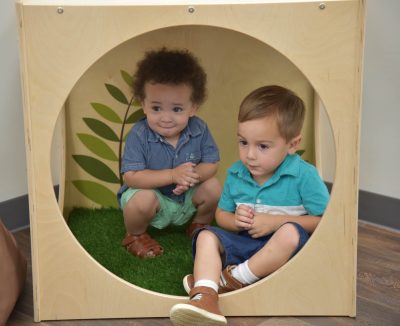
A Safe Space & Simulated Nature Experience
Our Nature Reading Cube (ANG1535P) is one piece of furniture we specifically designed to provide a simulated nature experience. It also provides the perfect retreat for kids who might be feeling stressed in three ways:
- It comes with an artificial turf mat. Kids will love touching the soft faux grass as they sit inside the cube, which will contribute to their sensory development.
- Environmentally friendly inkjet technology is used to print ferns, a caterpillar, a ladybug, and a butterfly on the back panel of the cube. This simulated nature scene is a great replacement when the real thing is not achievable.
- The cube is constructed from birch veneer to bring wood into this simulated natural environment.
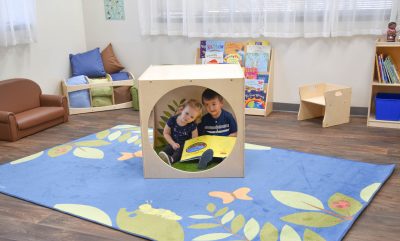 (Partner it with our Friendly Fern Carpets in blue or brown for a perfect match to the graphics inside the cube. [CPR3077, CPR3076, and CPR3074.])
(Partner it with our Friendly Fern Carpets in blue or brown for a perfect match to the graphics inside the cube. [CPR3077, CPR3076, and CPR3074.])
Sensory & Motor Development
As infants and toddlers grow, it’s imperative we facilitate the use of all five senses. Using sight, sound, smell, taste, and touch to experience the world helps cognitive development as the brain and body form neural connections. Natural environments stimulate curiosity, exploration, and discovery. It provides the wings for a child’s imagination to take flight as they develop.
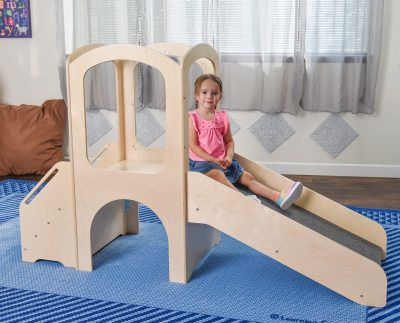
Promote gross motor development with wood play equipment like the Toddler Loft. It’s perfect for adhering to biophilic design principles. (ANG1617)
Place children in nature and you will easily get all five senses working together. Imagine a child climbing over small rocks, hearing the wind rush and water trickle, noticing different colors and scents of flowers, and feeling the grass as they roll down a gentle slope.
Yet, children cannot be outside experiencing nature on field trips constantly. Therefore, with children and adults spending more and more time indoors, inserting some natural elements into our built environments should become a priority. Providing some wood play equipment versus all plastic equipment could provide the extra sensory experience kids need.
Attention Span & Ability to Focus on Learning
In the 1980’s, Attention Restoration Theory was first developed. This theory proposes nature is enjoyable and restores our ability to think and concentrate. Why? Researchers postulate it is the simplicity found in nature that rejuvenates people of all ages. Nature is simple. It surrounds us with calmness as we take a break from more taxing noises, lights, traffic, crowds of people and things found in the city.
The nurturing effect of nature is multi-dimensional. Something as simple as adding indoor plants to classrooms adds to the amount of oxygen in the air. When children have enough oxygen, they are better able to focus.
The EPA has reported indoor air-pollution is America’s #1 environmental threat to health. A lack of ventilation is just one an example of how air-quality affects our health. Simply opening windows or a door to the outdoors not only connects students to nature, but it allows air to circulate. Benefits to health and well-being include:
- Reduction in asthma or allergy triggers
- Improved concentration
- Decreased headaches
- Less fatigue
- Less absenteeism caused by the spread of colds and germs
Plants, Air Quality and Sunlight
NASA’s research in 1989 found many plants remove toxins from the air inside space capsules. Plants cleansed unhealthy substances such as benzene, formaldehyde, and trichloroethylene from the air. Homes, offices, and institutions experience the same effect when we introduce plants to the environment. Some of the most effective plants include: bamboo palm (chamaedorea seifrizii), heartleaf philodendron (philodendron cordatum), variegated sanseviera ‘snake plant’ (dracaena trifasciata ‘laurentii’), Chinese evergreen (aglaonema modestum), peace lily (spathiphyllum ‘mauna loa’), and English ivy (hedera helix). Additionally, students learn empathy and form a deeper connection to nature when helping to care for plants.
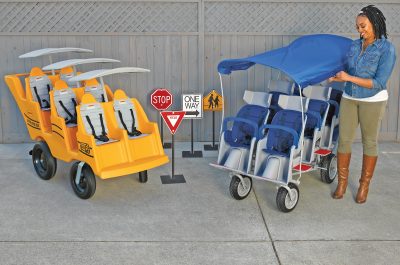
The 6 Passenger RunAbout® Stroller (left – AFB6850F) is pictured here with Angeles’s Never Flat “Fat Tire” Bye-Bye® Bus (right – AFB6400SB).
Research conducted in 2000 by the National Renewable Energy Laboratory provided evidence showing exposure to sunlight profoundly improves student performance. NREL’s analysis of 21,000 students located across three school districts in the states of Washington, Colorado, and California exposed some interesting results. Students with the most daylight in their classrooms progressed 20% faster on math tests and 26% faster on reading tests when compared to students whose classrooms provided the least amount of daylight.
Outdoor Excursions
Classrooms lacking windows or doors connected to outdoor spaces can choose to take little ones on small nature trips. It’s a fabulous way for tikes to recharge their batteries. Angeles’s RunAbout 6 Passenger Stroller (AFB6850F) features stadium seating so each row of kids has a great view of the calming landscape. The seats recline up to 14 degrees for additional comfort and the stroller includes a water and fade resistant canopy to protect tots from the elements.
Key Take Aways from Biophilic Design
Biophilic design brings together the human desire to harmonize with nature with our requirement for built environments. The future of urban environments is especially dependent on society’s ability to understand how we can better encourage and promote positive interactions and connections to the natural world. Children require repeated and sustained engagement with natural elements for any positive effects to take place.
Yet, understanding is not enough. Implementing those best practices will ensure each generation experiences better health, fitness, and an overall sense of well-being we might call (for lack of a better word) happiness. Biophilic design, ideally, will enhance our emotional attachment to specific settings and places and contribute to our feelings of interconnectedness. It will expand our sense of relationship and responsibility for the human and natural communities.
As it pertains to the growth and development of children, research on how biophilic design positively affects the attention span, sensory and motor development, stress levels, visual acuity, and more is conclusive. It’s one way we can offset the negative impact of ever-increasing exposure to technology in the form of screen time.
References:
- https://metropolismag.com/projects/what-is-and-is-not-biophilic-design/
- https://www.inprocorp.com/resources/blog/biophilic-design-in-education/
- https://www.cbc.ca/news/health/nature-health-1.5128482?cmp=newsletter-news-digests-canada-and-world-evening
- https://www.researchgate.net/figure/BROWNING-ET-AL-2014-14-PATTERNS-OF-BIOPHILIC-DESIGN_tbl1_313654539
- https://www.nrel.gov/docs/fy00osti/28049.pdf
- https://hgic.clemson.edu/indoor-plants-for-the-classroom/
- http://www.wolvertonenvironmental.com/NASA-Report-89.pdf
- https://www.designboom.com/technology/nasa-clean-air-study-plants-natural-filter-06-13-2021/